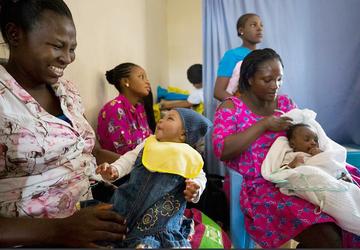
NEW YORK, New York, June 17, 2019 (ENS) – There will be roughly 9.7 billion people living on Earth by the year 2050, an increase of two billion over today’s population, finds a UN population report released today. India is predicted to overtake China, today’s most populous country by 2050; and the population of sub-Saharan Africa is projected to double.

“The World Population Prospects 2019: Highlights,” estimates that the next 30 years will see today’s global population of 7.7 billion add another two billion people, and, by the end of the century, the planet will have to sustain around 11 billion people, the report shows.
Yet, the overall population growth rate will continue to fall, and according to the report, the world’s population is expected to virtually stop growing by 2100.
The report is published by the Population Division of the UN Department of Economic and Social Affairs and provides a comprehensive overview of global demographic patterns and prospects. Based on population estimates from 1950 to the present for 235 countries or areas, it’s underpinned by analyses of historical demographic trends.
Data released by Pew Research Center on Monday based on the same UN report indicates that falling global fertility rates will lead to a population of about 10.9 billion people at the end of the century, with what analysts say is annual growth of less than 0.1 percent.
India is expected to experience the greatest population increase between now and 2050, overtaking China as the world’s most populous country by around 2027. India, along with eight other countries, will make up over half of the estimated population growth between now and 2050.
The nine countries expected to show the biggest population increases are India, Nigeria, and Pakistan, followed by the Democratic Republic of Congo, Ethiopia, Tanzania, Indonesia, Egypt, and the United States.
In total, the population of sub-Saharan Africa is expected to practically double by 2050.
Population growth in these countries will happen against the backdrop of a slowing global fertility rate. In 1990, the average number of births per woman was 3.2. By 2019 this had fallen to 2.5 births per woman and, by 2050, the birth rate is projected to decline further to 2.2 births.
In the absence of immigration, a fertility level of 2.1 births per woman is necessary to avoid national population decline over the long run.
The population size of more and more countries is falling. Since 2010, 27 countries or areas have seen a drop of at least one percent, because of persistently low fertility rates.

Between now and 2050, the group of countries that will see a population decrease of one percent or more is expected to expand to 55. And almost half of these will experience a decrease of at least 10 percent.
In some cases, the falling population size is accompanied by high rates of emigration, and migration flows have become a major reason for population change in certain regions.
Bangladesh, Nepal and the Philippines are seeing the largest migratory outflows resulting from the demand for migrant workers; Myanmar, Syria and Venezuela are the countries where the largest numbers are leaving because of violence, insecurity or armed conflict.
For those countries where the population is falling, immigration is expected to fill the gaps, particularly in Belarus, Estonia and Germany.
“Many of the fastest growing populations are in the poorest countries, where population growth brings additional challenges,” said Liu Zhenmin, United Nations Under-Secretary-General for Economic and Social Affairs. These challenges include the fight to eradicate poverty, and combat hunger and malnutrition; greater equality; and improved healthcare and education.
The report, Liu said, offers a “roadmap” indicating where to target action and interventions.
At the same time, growth is providing opportunities in many developing economies. Recent reductions in fertility mean that the working-age population, considered to be 25 to 64, is growing faster than other age ranges, which could improve the possibilities for faster economic growth.
The report recommends that governments make use of this “demographic dividend” to invest in education and in health.
The proportion of older people in the population is increasing, although life expectancy is still lower in poorer countries. In the future, more countries will have to adapt to the consequences of an aging population, the UN report finds.
There will be one in six people older than 65 by 2050, up from the current figure of one in 11. Some regions will see the share of older people double in the next 30 years, including Northern Africa, Asia and Latin America.
By 2050, a quarter of the population in European and Northern America could be 65 years of age or over. The higher proportion and number of older people is expected to put increased financial pressure on countries in the coming decades, with the higher cost of public health, pensions and social protection systems.

Although overall life expectancy will increase from 64.2 years in 1990 to 77.1 years in 2050, life expectancy in poorer countries will continue to lag behind these numbers.
Today, the average lifespan of a baby born in one of the least developed countries will be about seven years shorter than a baby born in a developed country. The main reasons are high child and maternal mortality rates, violence, and the continuing impact of the HIV/AIDS epidemic.
The United Nations is highlighting the important role that population trends play in promoting sustainable development during the annual Commission on Population and Development, which began at UN Headquarters in New York today.
Research shows that slowing global population growth can help mitigate climate change by reducing future carbon emissions by up to 29 percent, says the nonprofit group Population Connection. “In fact,” says the group, “the impacts of slower population growth are so expansive that they have the potential to help achieve all 17 of the UN’s Sustainable Development Goals for 2030.”
Population Connection, based in Washington, DC, advises that the best way to reduce population growth is voluntary access to family planning.
From an environmental perspective, family planning is increasingly being identified as a “critical, human rights-based, and cost-effective approach” to climate change resilience and adaptation strategies.
Recent estimates show that family planning, together with girls’ education, could prevent around 120 gigatons of CO2 equivalent by 2050 – more than large-scale innovations in onshore and offshore wind power combined, which amounts to 99 gigatons.
Because family planning enables women to autonomously manage whether and when they become pregnant, one significant outcome is increased education rates for women and girls throughout the world. And, because higher levels of education afford more options for sustained employment and ultimately increase livelihoods, women who are educated tend statistically to have fewer, healthier children.
Homi Kharas of the Brookings Institution maintains, “It is education, or more specifically girls’ education, that is far more likely to result in lower carbon emissions than a shift to renewables, improved agriculture practices, urban public transport, or any other strategy now being contemplated.”
Copyright Environment News Service (ENS) 2019. All rights reserved.
© 2019, Environment News Service. All rights reserved. Content may be quoted only with proper attribution and a direct link to the original article. Full reproduction is prohibited.
